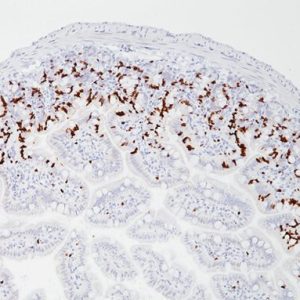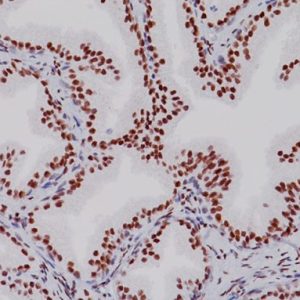Description
IMP3 (insulin-like growth factor II mRNA-binding protein 3) is a 580 amino acid oncofetal RNA binding protein containing four K homology domains which is encoded by a 4350 bp mRNA transcript produced by the IGF2BP3 gene on chromosome 7p11.5 (1,2). Its relevance as a novel biomarker in many kinds of cancer has been recently published and data also suggest that IMP3 may play an important role in malignant transformation (3). Cytoplasmic expression of IMP3 has been associated with a more aggressive phenotype in many cancers including triple negative (basal-like) breast cancers, colon cancers, lung cancer and prostate cancer (4-7). IMP3 has also been used in discriminating between benign vs malignant cancers and IMP3 has been shown to be a marker of high-grade dysplasia in esophageal adenocarcinoma (3, 8-10).
SPECIFICATIONS
Specifications
| BY LETTER | I |
|---|---|
| CLONE | EP286 |
| FORMAT | Concentrate, Predilute |
| INTENDED USE | IVD |
| ISOTYPE | IgG |
| LOCALIZATION | Cytoplasmic / nuclear |
| SOURCE | Rabbit Monoclonal |
| VOLUME | 0.1 ml, 0.5 ml, 6.0 ml |
| SPECIES REACTIVITY | Human; others not tested |
DATASHEETS & SDS
REFERENCES
1. Mueller-Pillasch F, et al. Cloning of a gene highly overexpressed in cancer coding for a novel KH-domain containing protein. Oncogene.
1997;14(22):2729–33.
2. Nielsen J, et al. A family of insulin-like growth factor II mRNAbinding proteins represses translation in late development. Mol Cell Biol. 1999;19(2):1262–70.
3. Lu D, et al. An oncofetal protein IMP3: a new molecular marker for the detection of esophageal adenocarcinoma and high-grade dysplasia. Am J Surg Pathol. 2009 Apr;33(4):521-5. Li D, et al. IMP3 is a novel prognostic marker that correlates with colon cancer progression and pathogenesis. Ann Surg Oncol. 2009 Dec;16(12):3499-506.
4. Walter O, et al. IMP3 is a novel biomarker for triple negative invasive mammary carcinoma associated with a more aggressive phenotype. Hum Pathol. 2009 Nov;40(11):1528-33.
5. Li D, et al. IMP3 is a novel prognostic marker that correlates with colon cancer progression and pathogenesis. Ann Surg Oncol. 2009 Dec;16(12):3499-506.
6. Beljan Perak R, et al. IMP3 can predict aggressive behaviour of lung adenocarcinoma. Diagn Pathol. 2012 Nov 28;7:165.
7. Chromecki TF, et al. Prognostic value of insulin-like growth factor II mRNA binding protein 3 in patients treated with radical prostatectomy. BJU Int. 2012 Jul;110(1):63-8.
8. Lee AF, et al. IMP3 and GLUT-1 immunohistochemistry for distinguishing benign from malignant mesothelial proliferations. Am J Surg Pathol. 2013 Mar;37(3):421-6.
9. Danialan R, et al. The utility of PAX8 and IMP3 immunohistochemical stains in the differential diagnosis of benign, premalignant, and malignant endocervical glandular lesions. Gynecol Oncol. 2013 Aug;130(2):383-8.
10. Mentrikoski MJ, et al. Diagnostic utility of IMP3 in segregating metastatic melanoma from benign nevi in lymph nodes. Mod Pathol. 2009 Dec;22(12):1582-7.
11. Center for Disease Control Manual. Guide: Safety Management, NO. CDC-22, Atlanta, GA. April 30, 1976 “Decontamination of Laboratory Sink Drains to Remove Azide Salts.”
12. Clinical and Laboratory Standards Institute (CLSI). Protection of Laboratory Workers from Occupationally Acquired Infections; Approved Guideline-Fourth Edition CLSI document M29-A4 Wayne, PA 2014.







Reviews
There are no reviews yet.